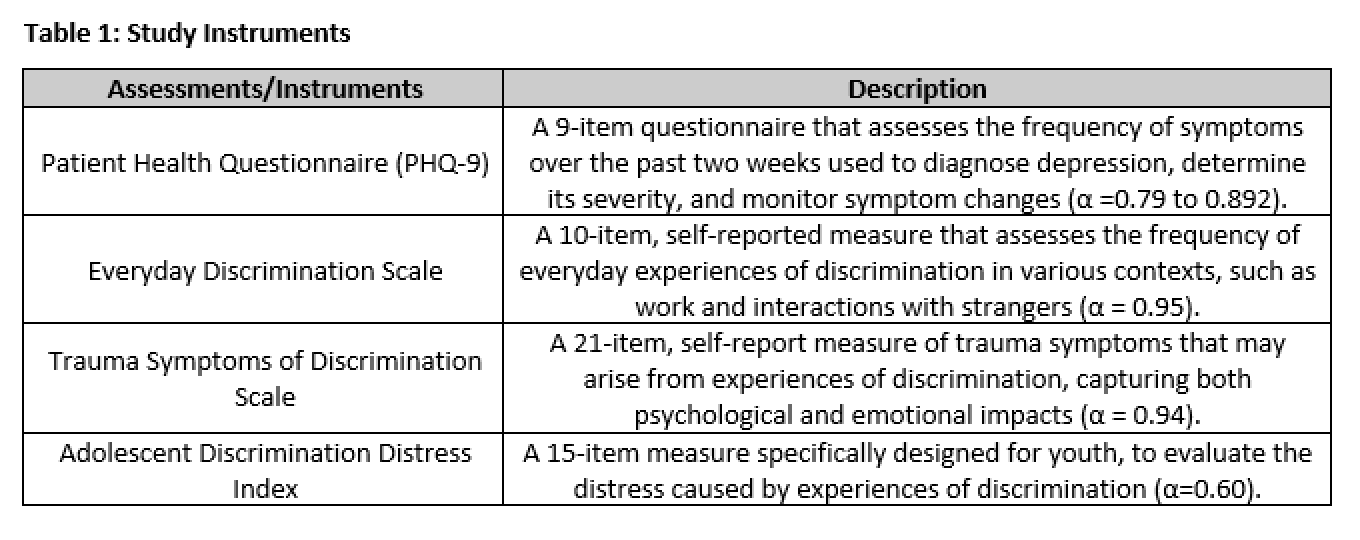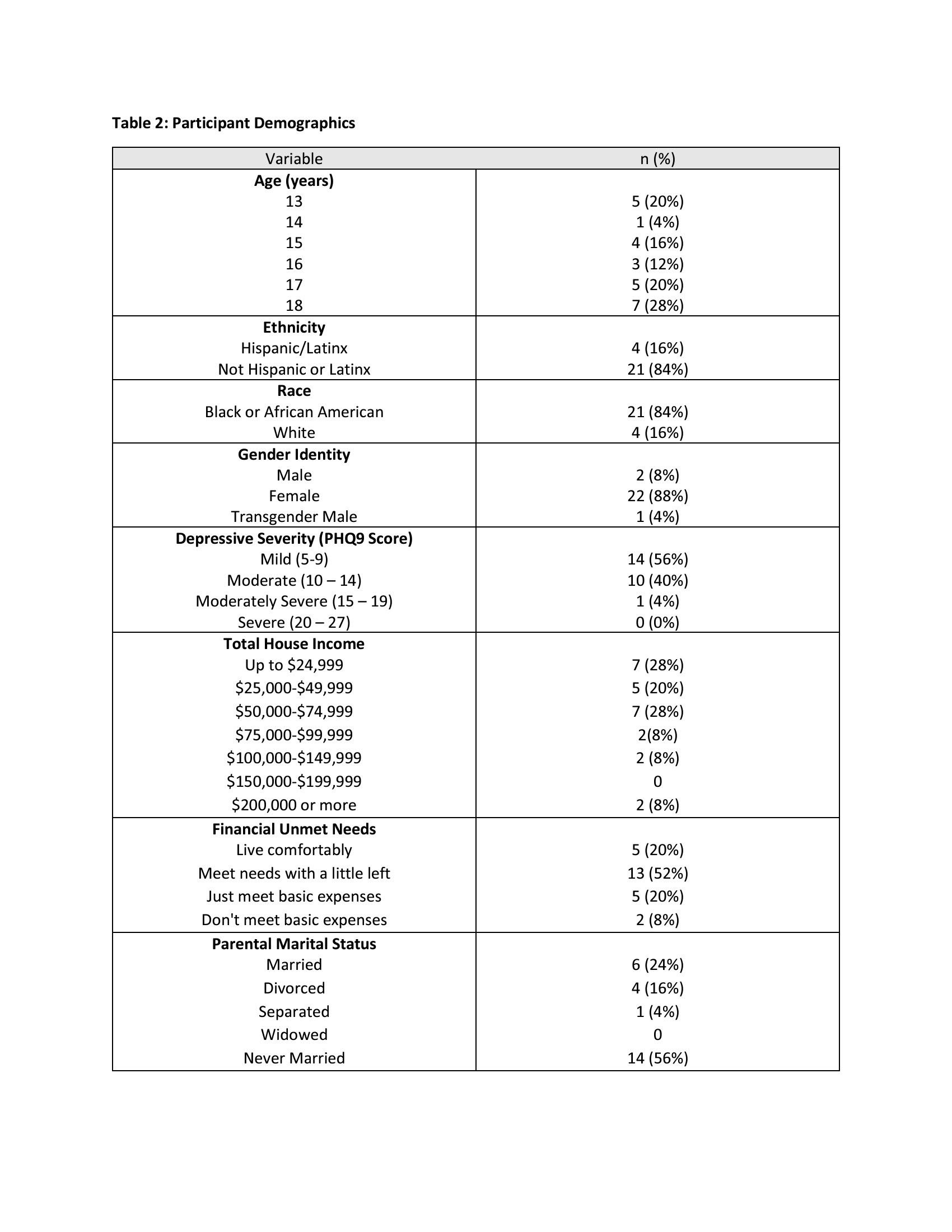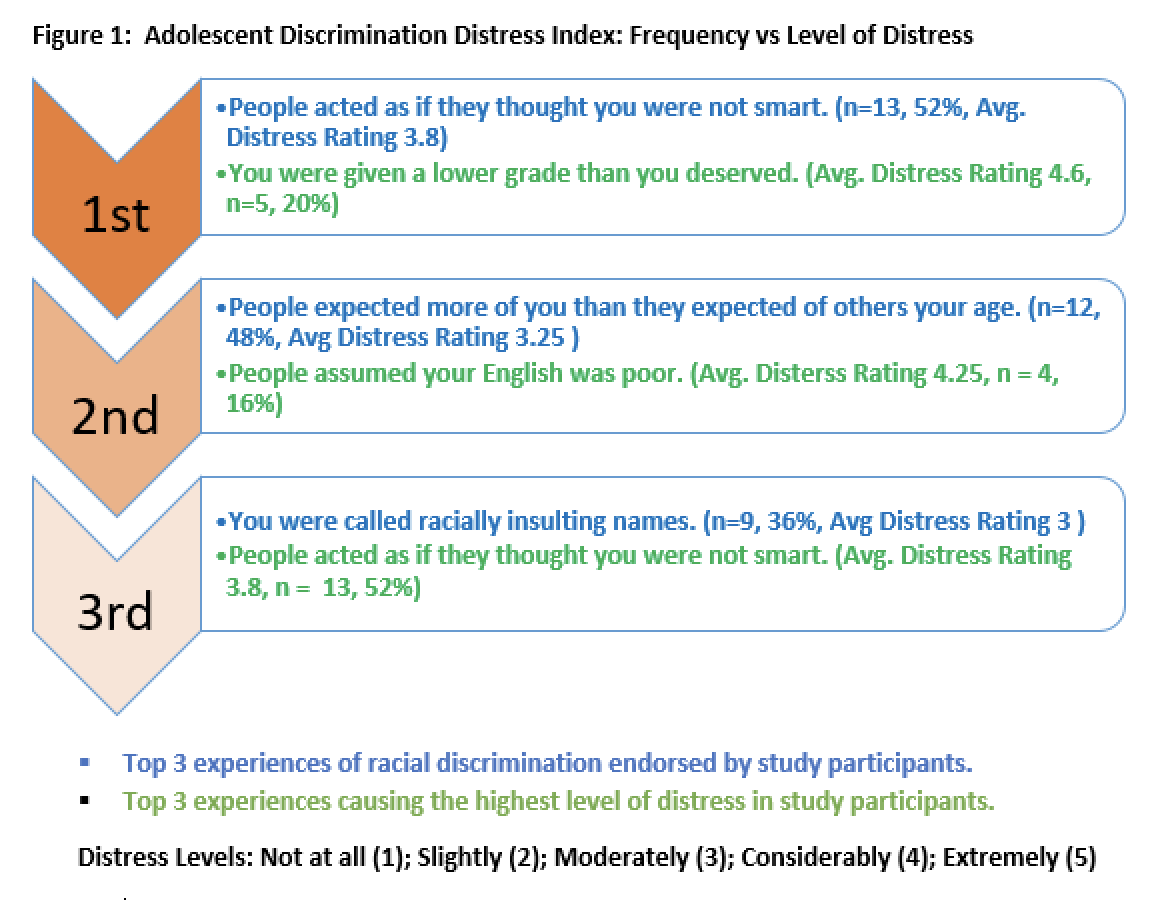Back
Background: The PATHway randomized control trial is evaluating the effectiveness of a digital health intervention, CATCH-IT, for preventing depression. Y.O.U. Matter is a NIMH-funded pilot study nested within the PATHway trial that aims to assess how well CATCH-IT improves depressive symptoms and reduces depression risk among Black and Latinx youth in relation to their experiences of racial discrimination and symptoms of racial trauma. To accomplish this, it is essential to effectively capture participants' experiences of racial discrimination.
Objective: To assess the feasibility and variability of the Everyday Discrimination Scale (EDS), Trauma Symptoms of Discrimination Scale (TSDS), Adolescent Discrimination Distress Index (ADDI), and the Hispanic Stress Inventory Version 2: Discrimination Subscale (HSIV2) in capturing experiences related to racial discrimination. These data will then be used to characterize the experiences of racial discrimination and symptoms of racial trauma in a cross-sectional cohort of Black and Latinx teens aged 13-18 who are at risk for depression.
Design/Methods: Black or Latinx participants enrolled in the PATHway trial were invited to participate in the Y.O.U. Matter Study (N=25). Assessments of racial discrimination and trauma (Table 1) were electronically distributed as an additional module during PATHway data collection. Assessments took approximately 20 minutes to complete and participants were compensated $15.
Results: Twenty-five teens were enrolled from March to July 2024 (Table 2). Combined, the ADDI and EDS captured experiences of racial discrimination in 96% of participants, compared to 80% for ADDI alone and 88% for EDS. In Latinx teens (n=4), the HSIV2 captured 100% exposure, while ADDI and EDS captured 50%. Among those reporting racial discrimination on the EDS, the average frequency was a few times per year (average score 2.14). ADDI results indicated that while participants frequently encountered discrimination, frequency did not correlate directly with distress. Overall, reported trauma symptoms were low, with an average TSDS score of 37.56 (range 21-61).
Conclusion(s): While there is no single best method to measure racial discrimination, the combined use of the EDS, TSDS, ADDI, and HSIV2 shows promise. Pilot data suggest that ADDI, EDS and HSIV2 together captured exposures to discrimination more effectively. Most participants experienced discrimination a few times a year and reported low trauma symptoms. Further evaluation will determine if these trends persist over time or are affected by the depression prevention intervention CATCH-IT.
Table 1. Study Instruments

Table 2. Participant Demographics

Adolescent Discrimination Distress Index: Frequency vs Level of Distress

Mental Health 3
Session: Mental Health 3
089 - Youth Often Underrepresented But Matter: The YOU Matter Study
Monday, April 28, 2025
7:00am – 9:15am HST
Kristen Kenan, University of Illinois at Chicago College of Medicine, Chicago, IL, United States; Tracy Gladstone, Brown University, Providence, RI, United States; Calvin Rusiewski, University of Illinois College of Medicine, Chicago, IL, United States; Shion Kabasele, Children's Hospital of the University of Illinois, Chicago, IL, United States; Henrika McCoy, University of Denver, Denver, CO, United States; William A. McDade, ACGME, Chicago, IL, United States; Devin D. Morgan, University of Illinois Chicago, Chicago, IL, United States; Pia M. Montenegro, Brown University School of Public Health, Providence, RI, United States; Marian L.. Fitzgibbon, University of Illinois Chicago, Chicago, IL, United States; Linda Schiffer, University of Illinois at Chicago, Oak Park, IL, United States; Michael L.. Berbaum, University of Illinois Chicago, Chicago, IL, United States; Benjamin W. Van Voorhees, University of Illinois, Chicago, IL, United States; Molly Martin, University of Illinois College of Medicine, Chicago, IL, United States

Kristen Kenan, MD, MPH (she/her/hers)
Assistant Professor of Pediatrics
University of Illinois at Chicago College of Medicine, United States
Presenting Author(s)
Background: The PATHway randomized control trial is evaluating the effectiveness of a digital health intervention, CATCH-IT, for preventing depression. Y.O.U. Matter is a NIMH-funded pilot study nested within the PATHway trial that aims to assess how well CATCH-IT improves depressive symptoms and reduces depression risk among Black and Latinx youth in relation to their experiences of racial discrimination and symptoms of racial trauma. To accomplish this, it is essential to effectively capture participants' experiences of racial discrimination.
Objective: To assess the feasibility and variability of the Everyday Discrimination Scale (EDS), Trauma Symptoms of Discrimination Scale (TSDS), Adolescent Discrimination Distress Index (ADDI), and the Hispanic Stress Inventory Version 2: Discrimination Subscale (HSIV2) in capturing experiences related to racial discrimination. These data will then be used to characterize the experiences of racial discrimination and symptoms of racial trauma in a cross-sectional cohort of Black and Latinx teens aged 13-18 who are at risk for depression.
Design/Methods: Black or Latinx participants enrolled in the PATHway trial were invited to participate in the Y.O.U. Matter Study (N=25). Assessments of racial discrimination and trauma (Table 1) were electronically distributed as an additional module during PATHway data collection. Assessments took approximately 20 minutes to complete and participants were compensated $15.
Results: Twenty-five teens were enrolled from March to July 2024 (Table 2). Combined, the ADDI and EDS captured experiences of racial discrimination in 96% of participants, compared to 80% for ADDI alone and 88% for EDS. In Latinx teens (n=4), the HSIV2 captured 100% exposure, while ADDI and EDS captured 50%. Among those reporting racial discrimination on the EDS, the average frequency was a few times per year (average score 2.14). ADDI results indicated that while participants frequently encountered discrimination, frequency did not correlate directly with distress. Overall, reported trauma symptoms were low, with an average TSDS score of 37.56 (range 21-61).
Conclusion(s): While there is no single best method to measure racial discrimination, the combined use of the EDS, TSDS, ADDI, and HSIV2 shows promise. Pilot data suggest that ADDI, EDS and HSIV2 together captured exposures to discrimination more effectively. Most participants experienced discrimination a few times a year and reported low trauma symptoms. Further evaluation will determine if these trends persist over time or are affected by the depression prevention intervention CATCH-IT.
Table 1. Study Instruments

Table 2. Participant Demographics

Adolescent Discrimination Distress Index: Frequency vs Level of Distress


